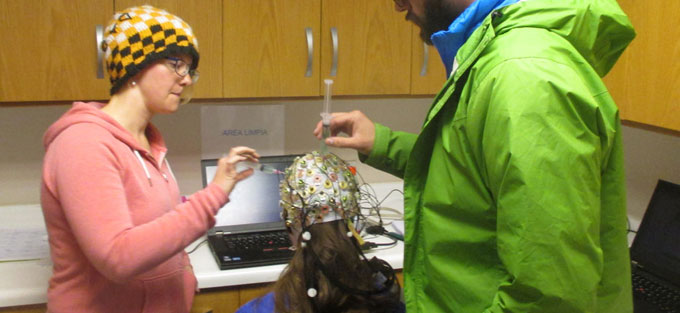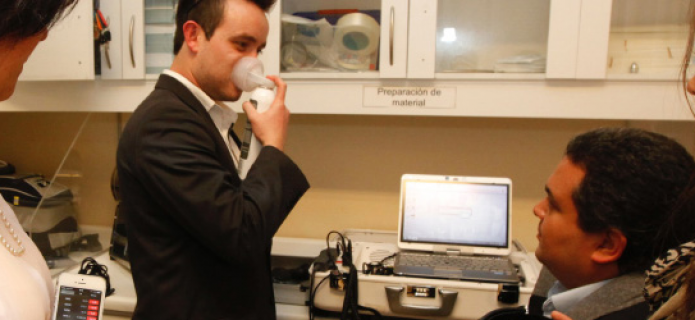ALMA workers were part of a research to reduce hypoxia effects
New studies by researchers from the University of Calgary, Canada, highlight the importance of acclimatization and improvement of blood oxygen level among high-altitude-experienced workers, to optimize performance of cognitively demanding work and reduce high-altitude-associated health risks. The results were published in High Altitude Medicine & Biology, the only peer-reviewed journal covering the medical and biological issues that impact human life at high altitude.
The research team investigated altitude effects on different cognitive domains among perennial shift-workers at the Atacama Large Millimeter/submillimeter Array (ALMA), at 5,050 meters above sea level, in Chile. ALMA employees were informed of the research, and twenty volunteers in good health were chosen to participate in the tests. The researchers evaluated their processing speed, their attention span and their executive functions. All the results obtained during the process were protected to ensure the anonymity of the participants.
“The altitude and extreme environment where the ALMA observatory is located make it a perfect laboratory for many sciences,” says ALMA Director, Sean Dougherty. “This study is not only useful for ALMA, but for a lot of other organizations that operate in very high altitude sites around the world. We are proud to be actively involved in advancing knowledge in this area.”
To observe the weak signals coming from the cold Universe, ALMA is located in a very high site, above most of the atmosphere, to avoid the water vapor that absorbs these signals. This is also one of the most arid areas in the world: the Atacama Desert. Due to its dryness, high altitude, clear skies and remoteness with scarce radio interference and light pollution, the Chajnantor Plateau is one of the best places on Earth for astronomic observation.
The ALMA staff spend most of their time at the Operations Support Facility (OSF) at 2,900m, but some of them must work on the antenna maintenance and relocations at the Array Operations Site (AOS) at 5,050m altitude.
While many studies investigate the acute effects of reduced amounts of oxygen in the body, a condition known as hypoxia, on cognitive function, only a few studies include high-altitude shift work. The staff at the ALMA observatory are mostly engaged in jobs that require high levels of focus, dexterity, and sustained attention. The weekly shift schedule that staff follow is designed to minimize the negative impacts of high altitude exposure; however, previous studies did not show beneficial effects of this work schedule.
The results of the new study show that ALMA staff have benefited from the periodic weekly alternating work-shift cycle for several years at high altitude, with minimal impairments in their cognitive functioning during acute exposure at 5050 meters altitude compared to 2.900 meters. However, the staff improved significantly their cognitive performances with acclimatization, process whereby the body adapts to the environmental modifications around them, in this case, altitude. These findings highlight the importance of acclimatization on cognitive function even among staff that work perennially at high-altitude.
“These studies will help us confirm and improve the action plan we follow to mitigate the effects of hypoxia on our staff” explains ALMA Health, Safety, Security & Environment manager, Iván López. “With the data and results from researchers, we are certainly going to make better decisions.”
Among the measures taken already by ALMA to reduce the effects of hypoxia on staff are the mandatory use of portable medical oxygen for all workers performing tasks over an altitude of 3,000 meters, permanent oxygenation of the AOS technical building, and constant on-site monitoring by the observatory’s medical team. On top of that, currently ALMA is carrying out other studies in collaboration with Chilean universities to develop a special diet and exercise program.
Additional Information
ALMA is a partnership between ESO (on behalf of its European Member States), NSF (USA), and NINS (Japan); together with NRC (Canada), MOST and ASIAA (Taiwan), and KASI (Republic of Korea), in cooperation with the Republic of Chile. The Joint ALMA Observatory is operated by ESO, AUI/NRAO, and NAOJ.
Contacts
-
Nicolás Lira
Education and Public Outreach CoordinatorJoint ALMA Observatory, Santiago - ChilePhone: +56 2 2467 6519Cel: +56 9 9445 7726Email: [email protected] -
Valeria Foncea
Education and Public Outreach ManagerJoint ALMA Observatory Santiago - ChilePhone: +56 2 2467 6258Cel: +56 9 7587 1963Email: [email protected]

